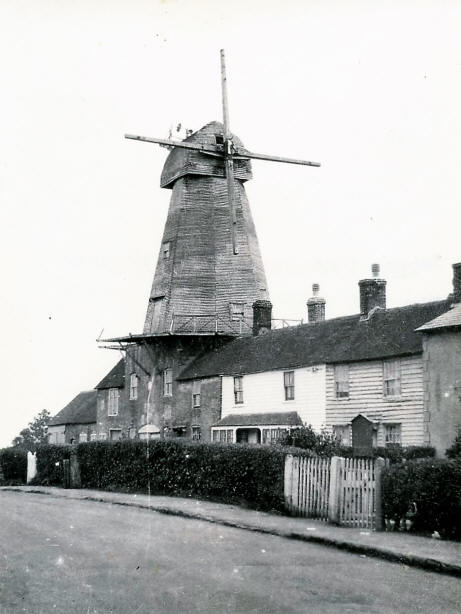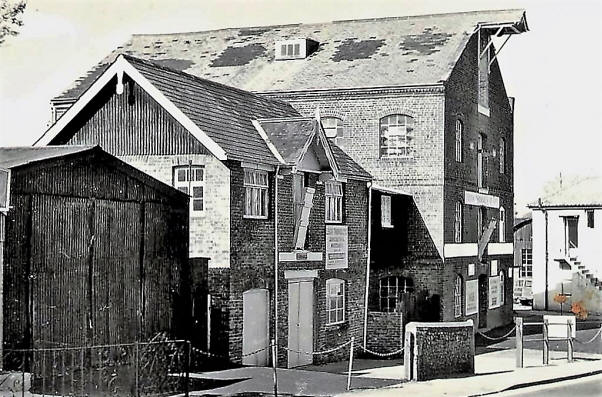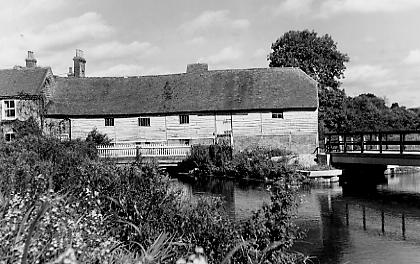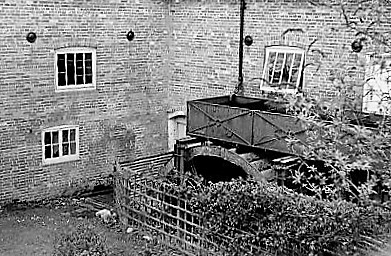|
  |
|
Page 8 |
Newsletter 114, Autumn 2016 © Hampshire Mills Group |
The
Arthur Lowe Photo Collection
Information
from Tony Yoward
|
|
Mr Lowe died on Sunday 18 August 1996 at the Gosport
Memorial Hospital aged 90 years. He was born on 2
April 1906.
He left his collection of maps
and photographs to the Hampshire Mills Group. The
photographs were put into archival hangers in seven
albums containing almost 1500 photographs, which
have now been deposited at The Mills Archive in
Reading.
A few of his earliest photos
are included below.
This article was
published in Yesterday in 1994.
Cycling into a Land full of Sails
|
|
On a cycle ride from his Gosport home in 1926,
Arthur Lowe espied the mill at Earnley, near
Chichester (pictured). The sails, two of canvas and
two shuttered, were turning in a brisk breeze and
seemed like arms beckoning him. He called on the
miller, a Mr Ellis, who showed him all over the mill
while flour was being ground. "The whole building
seemed alive with the creaking of wooden machinery
and the rumble of the stones, and it was quite
absorbing. From then on I was fascinated by mills,
wind and water, and they have been important to me
ever since" said Mr Lowe, of Braemar Road,
Bridgemary, Gosport. Since that day he has visited
many mills, later adding dovecotes to his interest,
and on his trusty bicycle has travelled all over
England to visit and photograph them.
His cycling mileage has topped 350,000, and the
tally of mills he has visited and photographed comes
to 600 watermills and more than 170 windmills. At
home he would pore over Ordnance Survey maps looking
out mills and planning his journeys. He covered
Hampshire. West Sussex, and adjoining counties, the
Isle of Wight was within easy reach, and he pushed
his boundaries further, Surrey, Kent, Essex,
Cambridgeshire, Lincolnshire. Weekends were full,
holidays were devoted to the further flung counties.
On the iron rail to Woking, then into the saddle,
and before long the eastern counties sped beneath
his questing handlebars. Now on his third bicycle
and third camera, Arthur still spends many happy
hours cycling to his beloved mills, often taking his
bike on a train in order to reach the far off ones,
having given up his car in 1958.
|
.jpg) |

Harebeating Mill, Hailsham (1930) |

Staple Cross Mill, Sussex (1931) |
|
In his prime he would average 70 miles a day,
sometimes more than 100 for a good mill, but now, at
83, he paces himself; lean and tanned, he still
manages a lively pace awheel, but reckons that 35
miles a day is quite enough, after all, a chap wants
to enjoy both the journey and the destination. One
week was the longest holiday period, and he
travelled as far as he could within the time,
gradually covering the Midlands and the south west.
First he concentrated on windmills, but by the late
1930s he had more or less run out, so he widened his
scope to watermills.
“Windmills were always prominent and more easily
destroyed than water mills. I like windmills but I
gradually got to like watermills more. They are
often hidden away in remote and very quiet places
and there is always running water. I got bitten by
them really, they were magical places. Often they
were at the end of little narrow tracks, and to see
them working was remarkable, the thundering wheel,
water rushing over or under, and the whole building
vibrating with the force of machinery”. Yet most
people didn't even know they were there.
“It just got hold of me and I visited as many as I
could.” He became a member of the Wind and Water
Mills Section of the Society for the Protection of
Ancient Buildings when it was inaugurated in 1934,
and now he belongs to four mill groups and is an
honorary member of the Hampshire Mills Group. |
|

Emsworth Town Mill |
Arthur is one up on many of the younger members in
that he was privileged to see quite a number of the
mills when they were working. Sadly, many of the
mills in his photographic collection exist no more.
“There were actually very few windmills in
Hampshire and I have seven of them on film.”
Arthur is a retired joiner whose family have been
builders in Gosport for many years and he has a
craftsman's interest in the skilled woodwork which
went into building the mills.
"Each mill has its own
character and is different in some particular. They
were all hand-built with local materials of stone,
of bricks, and quite a lot were all wood. Massive
shafts, usually of pine, great spurwheels of oak, up
to ten or 12 feet in diameter were fitted with
applewood teeth which had to mesh accurately with
bevel gears to drive the stone nut. There were
ingenious methods of disengaging the drive to the
stone or stones; other machinery, such as the flour
dresser, was driven off the main shaft. When the
mill was in gear and grinding the miller could get
on with other jobs, the hopper feeding the stones
automatically, a little gadget called a damsel, an
iron forging agitating the shoe of the under-driven
stones. An alarm bell rang if the stones ran dry.
After the church, the mill was the most important
secular building to exist, from medieval times right
up to the end of the 18th century, and many villages
had two mills." He believes there may be as many as
60 windmills in England in working order or capable
of working, and among them just a few still working
commercially. Six windmills at least have been
restored to near working order by the Norfolk Mills
Trust. Many more water mill buildings have
survived, well over 100 of them capable of working. |
|
There are heroic tales of the hard work put into
restoring mills, much of it by volunteers, and
Arthur knows of a young man and wife hard at work
restoring a Dorset mill right now, a project that
has taken them two years so far. It is an expensive
business – putting two new pairs of sails on a
windmill costs £10,000. Counties with lots of
rivers and streams have plenty of mills, but with
water extraction and falling water tables, quite a
few have been left dry of motive power. Every
village in the Meon Valley had a water mill at one
time. Best known for grinding the flour for bread –
often a bakery was part of the complex – mills have
also been used for making gunpowder, especially
around the Medway in Kent, or for grinding stone for
pottery making in Staffordshire. There were fulling
mills where cloth was prepared, particularly in
Gloucestershire, many were used for preparing animal
feed, and other mills produced paper. Bere Mill at
Whitchurch, Hampshire, once produced paper for the
Bank of England. Off the A34 between Winchester and
Newbury is a fine and rare silk mill, open to the
public, where a water wheel occasionally drives some
of the machinery for spinning. The death knell for
most ‘green’ powered flour mills came with the
advent of steam and mass production using huge steel
rollers, but the ones that are left are seeing a
revival of interest. |
|

Barton Mill, Basing |

Waltham Chase Mill |
|
Arthur is pleased by this and was delighted by the
goings on at Bartley on the Sussex-Kent border last
year. Wheat was cut, ground in the nearby mill and
baked into bread next door, all within seven hours –
you can't get fresher bread than that. So many
miles were covered by Arthur's second bicycle on the
mill quests that it got metal fatigue and the frame
actually broke in half while he was riding it in
Dorset. He found a new frame and used all the other
bits from his old bike, including the hub gears, and
carried on. Then his much prized, three-inch
dropped handlebars (known as Lauterwassers, he
learned from author Eric Newby) snapped off. Since
then he has had to make do with flat ones, which he
doesn't like as much. He admits to having any
amount of spills from his bike and once ended up in
Hastings Hospital having been found unconscious in
the road. "Cycling is not as pleasant as it was,
because of the motor traffic, but that does not put
me off. I am out on my bike every day, rain or
shine." His favourite mills are Hockley Mill near
Twyford, in Hampshire, beautifully kept by its owner
though not working, and Sheffield Mill, Furners
Green, East Sussex, smaller scale with a huge pond.
When he was last at Sheffield the wheel-buckets of
the overshot mill (the water hits the wheel from the
top) were gone but the 18th century machinery was
still in fair order inside. Not long ago he saw
that mill house and mill were for sale, but it was
just a little beyond his reach – £600,000!
The skills necessary to restore mills to working
order have not died out, and there are some six or
seven professional millwright companies in the
country, including one busy engineering concern in
West Sussex, E Hole & Son Ltd of Mill Road, Burgess
Hill, which operates mainly in Sussex and Kent and
has done work on Eling tide mill near Southampton,
and on Bursledon windmill in Hampshire.
This article was written in 1994, and it is
fascinating to see how the mills have fared since.
Congratulations to Tony for ensuring that the photos
have survived. Editor.
|
  |
|
|
